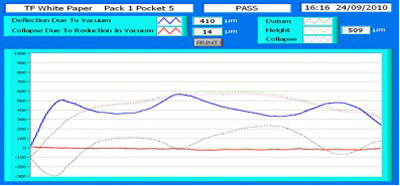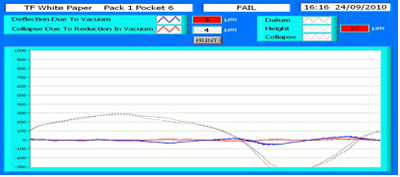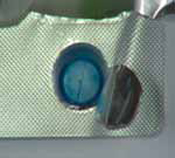Overview
A new whitepaper by a leading packaging expert from the University of Ulster, Dr Dorian Dixon, into the integrity of pharmaceutical packaging has established that existing methods for testing the seal integrity of blister packs are not as accurate as newer, technology-based test equipment.
In particular Dr Dixon found that the laser based Blisterscan, manufactured in the UK by Sepha, was capable of detecting 15% more product defects than traditional blue dye test methods used by the majority of the pharmaceutical market.
In a global market valued at more than US$40bn per annum, where quality control is of paramount importance, a 15% difference in the ability to detect if a product is sealed correctly or not is significant.
Dr Dixon’s whitepaper, “Assessing the Integrity of Pharmaceutical packaging using Sepha Blisterscan and Blue Dye Testing”, comes on the back of internal studies by Sepha highlighting that Blisterscan, a laser-based leak detection machine, was capable of identifying 50% more defects in blister packs with 10µm holes than blue dye test methods.
A preliminary study was conducted by Dr Dixon to determine the ability of Blisterscan to identify defects in a wide range of blister pack designs. A Design of Experiment approach was used to investigate the effect of pocket dimensions, foil thickness, pack material and defect size on detection rates by both Blisterscan and blue dye testing.
This study found that the Blisterscan test method detected 100% of 15μm sized holes, while only 85% of such defects were picked up by blue dye testing.
In his whitepaper study Dr Dixon compared the ability of Blisterscan and the blue dye test to detect defective pockets in blister packs. 30-cavity PVC thermoformed packs sealed with a 25μm foil laminate were used, with 12μm or 20μm sized holes laser drilled in the packs to create defective packs. 90 pockets were tested for each of the three sample types investigated (defect free, 12μm holes or 20μm holes).
The model defects were laser drilled in the approximate centre of the foil laminate covering each pocket and the dimensions of the holes were confirmed to a tolerance of +/-2μm using an electron microscope.
Current standard
The current industry standard for testing blister pack integrity is blue dye testing, which consists of placing a selection of packs into blue stained water, subjecting the packs to a vacuum of typically 400-600mBar for several minutes and then removing the vacuum, which allows any defective pockets to take up the dye. The packs are manually deblistered and inspected for dye ingress. This technique relies on human subjectivity, and Dr Dixon states that it is unlikely that the accuracy he achieved in his laboratory tests could be reproduced during routine factory quality control procedures.

Blisterscan testing consists of initially scanning the surface of each pocket in order to provide a datum value for subsequent deflection measurements
Blisterscan is a dry, nondestructive technique that uses a laser to measure changes in the pack profile which result from applying a vacuum. The lidding material of defective pockets will respond in a different manner to a perfectly sealed pocket when a vacuum is applied. Dr Dixon states that the approach is preferable to systems that rely on contacting the lid material with a probe in order to measure pressure or displacement.
Blisterscan testing consists of initially scanning the surface of each pocket in order to provide a datum value for subsequent deflection measurements. A vacuum level of 500mbar is then applied and held for 10 seconds and the pack remeasured.
Deflection refers to the difference in average height when the vacuum is applied compared with the datum value. The vacuum level is then reduced to 400mBar and held for a further 30 seconds before the pack is scanned again. The variation in average height at the full and reduced vacuum is referred to as collapse.
Figure 1a illustrates the typical difference in deflection behaviour measured by Blisterscan between a defect free pocket (bottom) and one containing a 30μm sized laser drilled defect (top). In Figure 1 the black dotted line is the profile of the foil surface before the vacuum is applied. It can be seen that a variation in profile exists between packs. The profiles after the full and reduced vacuum is applied are shown by the green and purple lines respectively.
The solid blue line denotes the deflection, which is the difference between the profiles before and after the vacuum is applied, while the red line illustrates collapse (difference between profiles at full and reduced vacuum).

Figure 1a: Blisterscan results of a pack containing a 30μm hole

Figure 1b: Blisterscan results of defect-free pack
It can be seen from Figure 1 that the pack with a 30μm hole does not deflect significantly from the initial profile when the vacuum is applied. The defect-free pocket (Figure 1b), however, displays a large deflection and adopts a domed profile as a result of the applied vacuum. In this case a deflection of 410μm was recorded for the defect-free packed compared with only 4μm for the pack containing the 30μm hole.
A large hole i.e. one greater than ~20μm allows the pressure inside the pocket to equalise to the applied vacuum inhibiting foil movement. Small holes manifest as a greater than normal collapse when the vacuum level is reduced. This occurs as the air slowly escapes through a small defect, allowing the pressure inside the pocket to equalise with the applied vacuum.

Figure 2: The destructive effect of blue dye on a tablet
Once the packs had been tested by Blisterscan they were then subjected to the blue dye test. Extensive trials observed that repeat testing packs on BlisterScan had no observable effect on the deflection behavior of the pack, or on the dimensions of any defects.
Multiple BlisterScan testing of the same defective pocket produced repeatable results. The non-destructive nature of the BlisterScan technique was also confirmed by electron microscopy analysis of defects before and after testing. The packs were submerged in methylene blue stained water and a vacuum of 500mBar was applied. This vacuum level was maintained for a soak time of 1 minute. The vacuum was then released with the packs remaining in the dye for a further period of 1 minute to allow the dye to penetrate any defective pockets. The pockets were then opened and the contents visually inspected for signs of dye ingress.
Findings
Building on Dr Dixon’s initial study where 100% of 15µm holes were detected, Blisterscan went on to detect 100% of the 20µm holes and 99% of the 12µm holes in the final whitepaper study. Conversely blue dye testing was only capable of detecting 85% of the 15µm holes, 90% of the 12µm holes and 99% of the 20µm holes.
| Table 1: Blisterscan test accuracy vs Blue Dye test accuracy | ||||
| Blisterscan detection accuracy | ||||
| Blue Dye detection accuracy | ||||
Commenting on the results of the whitepaper, Dr Dixon said, ‘Blisterscan testing is a rapid non-destructive test method that can detect the presence of 12µm, 15µm and 20µm sized defects in pharmaceutical blister packaging with a higher degree of reliability than conventional blue dye testing.’ Dr Dixon went on to conclude that ‘The nonsubjective nature of Blisterscan testing removes the possibility of human error and reliance on operator judgement, which is a key element in the correct identification of small holes using traditional blue dye testing.’
As manufacturers seek to improve their levels of quality control and drive costs down, Blisterscan represents a significant improvement over traditional blue dye testing. Sepha believes that the accurate and repeatable results proven by this academic whitepaper, mean that Blisterscan is the definitive method for testing blister packs in the modern global pharmaceutical market.
